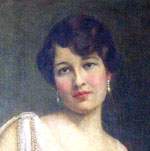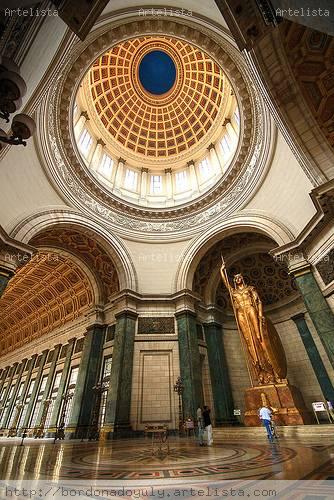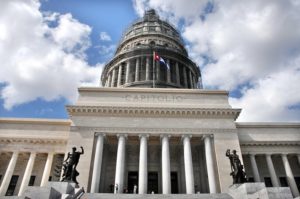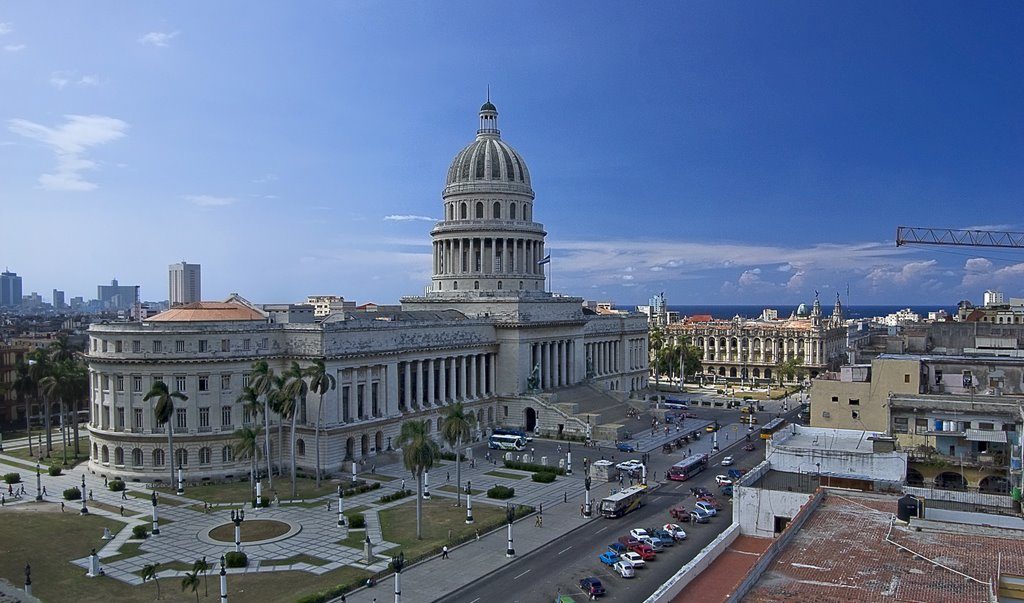 LA TERCERA ESTATUA MÁS GRANDE DEL MUNDO, LA DE NUESTRO CAPITOLIO NACIONAL “REPÚBLICA DE CUBA”
LA TERCERA ESTATUA MÁS GRANDE DEL MUNDO, LA DE NUESTRO CAPITOLIO NACIONAL “REPÚBLICA DE CUBA”
Escultura de bronce ubicada en el Capitolio de La Habana, tiene una altura total de 17,54 metros, lo que la convierte en la tercera mayor estatua bajo techo que existe en el mundo. La primera es el Buda de Oro de Nova, en Japón; la segunda el Memorial Lincoln, en Washington
Esta importante estatua, la de nuestra república, está emplazada en la rotonda que divide en dos el Salón de los Pasos Perdidos del Capitolio de La Habana.
La historia de esta simbólica estatua comenzó en 1927, cuando el doctor Carlos Miguel de Céspedes, secretario de Obras Públicas del gobierno del general Machado, invitó a La Habana al celebre escultor italiano Ángelo Zanelli, quien gozaba de gran fama por las obras que había realizado, entre ellas en 1911 el friso del Altar de la Patria en la capital italiana.
Zanelli, se había inspirado en Atenea, la diosa griega de la industria, las artes, la sabiduría y la guerra, pero sus formas y su rostro debían tener las peculiaridades propias de la mujer cubana y se dio a la tarea de buscar una modelo. La encontró en una mulata habanera de elegante figura llamada Lily Valty. Sin embargo, su rostro no encajaba con la que él había concebido para su obra.
Fue por casualidad que su amigo y coterráneo Stefano Calcavecchia le presentó a su esposa, Elena de Cárdenas y Echarte, una criolla cuyas facciones coincidían con el ideal soñado por el escultor. El maestro quedó deslumbrado con el rostro de esta mujer, en cuyas facciones bien definidas creyó encontrar su fuente de inspiración. Con ambas mujeres hizo varios estudios escultóricos en miniatura y con los apuntes, bocetos, maquetas y los planos del edificio regresó a su estudio en Roma para el colosal proyecto.
La estatua de la República fue realizada en Roma en el taller de Ángelo Zanelli. Le llevó dos años realizar la obra que tiene una altura de 11,50 metros desde la base hasta la cabeza a la que hay que añadir el brazo y la lanza que alcanza una altura total de 14,60 metros y descansa sobre un pedestal de mármol de 2,50 metros. Pesa 30 toneladas. Fue trasladada en un vagón especial hasta el puerto de Nápoles para ser embarcada a La Habana el 17 de abril de 1929. La efigie rodeada por el escultor y los 24 ayudantes y obreros que intervinieron en su realización dan una idea del colosal tamaño de la obra.
La estatua llegó a La Habana en tres grandes embalajes que tuvieron que ser cargados en hombros para poder subirlos por la gran escalinata. Se ensambló con absoluta perfección pocos días antes de la inauguración del Capitolio, el 20 de mayo de 1929. Fue colocada en el Salón de los Pasos Perdidos un día antes de la inauguración.
Zanelli tituló a su obra ‘La virtud Republicana’, aunque en Cuba se ha conocido simplemente como la “Estatua de La República”, de La Patria o de La Libertad. En su interior, la estatua tiene unos poderosos tensores que la sostienen y un túnel subterráneo que comienza en un salón cercano posibilita el acceso a esta zona.
La figura muestra a una gallarda mujer ataviada con una túnica y un gorro frigio y armada de una lanza en su mano derecha mientras que la izquierda mantiene un escudo que se apoya en el suelo. Y representa a la siempre y querida Nuestra República de Cuba.
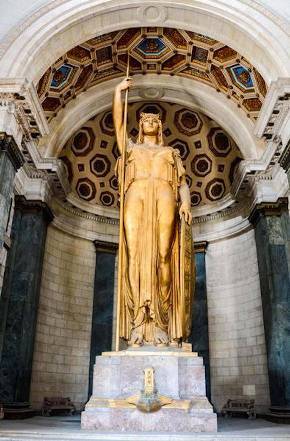 THE THIRD LARGEST STATUE OF THE WORLD, THAT OF OUR NATIONAL CAPITOL “REPUBLIC OF CUBA”
THE THIRD LARGEST STATUE OF THE WORLD, THAT OF OUR NATIONAL CAPITOL “REPUBLIC OF CUBA”
Bronze sculpture located in the Capitol of Havana, has a total height of 17.54 meters, which makes it the third largest indoor statue that exists in the world. The first is the Golden Buddha of Nova, in Japan; the second the Lincoln Memorial, in Washington
This important statue, that of our republic, is located in the rotunda that divides the Hall of the Lost Steps of the Capitol of Havana in two.
The history of this symbolic statue began in 1927, when Dr. Carlos Miguel de Céspedes, Secretary of Public Works of the government of General Machado, invited to Havana the famous Italian sculptor Ángelo Zanelli, who enjoyed great fame for the works he had done , among them in 1911 the frieze of the Altar of the Fatherland in the Italian capital.
Zanelli, had been inspired by Athena, the Greek goddess of industry, arts, wisdom and war, but his forms and his face had to have the peculiarities of the Cuban woman and was given the task of looking for a model. He found her in a Havana mulatto with an elegant figure called Lily Valty. However, his face did not fit with the one he had conceived for his work.
It was by chance that his friend and fellow Spaniard Stefano Calcavecchia introduced him to his wife, Elena de Cárdenas and Echarte, a Creole whose features coincided with the ideal dreamed by the sculptor. The teacher was dazzled by the face of this woman, in whose well-defined features he thought he found his source of inspiration. With both women he made several sculptural studies in miniature and with the notes, sketches, models and plans of the building he returned to his studio in Rome for the colossal project.
The statue of the Republic was made in Rome in the workshop of Angelo Zanelli. It took him two years to make the work that has a height of 11.50 meters from the base to the head to which we must add the arm and the spear that reaches a total height of 14.60 meters and rests on a marble pedestal 2.50 meters. It weighs 30 tons. It was transported in a special wagon to the port of Naples to be shipped to Havana on April 17, 1929. The effigy surrounded by the sculptor and the 24 assistants and workers who intervened in its realization give an idea of the colossal size of the work .
The statue arrived in Havana in three large packages that had to be carried on the shoulders to be able to climb them up the great staircase. It was assembled with absolute perfection a few days before the inauguration of the Capitol, on May 20, 1929. It was placed in the Hall of the Lost Steps one day before the inauguration.
Zanelli titled his work ‘Republican Virtue’, although in Cuba it has been known simply as the “Statue of the Republic”, of La Patria or La Libertad. Inside, the statue has powerful tensors that support it and an underground tunnel that starts in a nearby room allows access to this area.
The figure shows a gallant woman wearing a tunic and a Phrygian cap and armed with a spear in her right hand while the left holds a shield that rests on the ground. And represents the always and dear Our Republic of Cuba.
Agencies/ EcuRHC/ Internet Photos/ Arnoldo Varona/ www.TheCubanHistory.com
THE CUBAN HISTORY, HOLLYWOOD.



